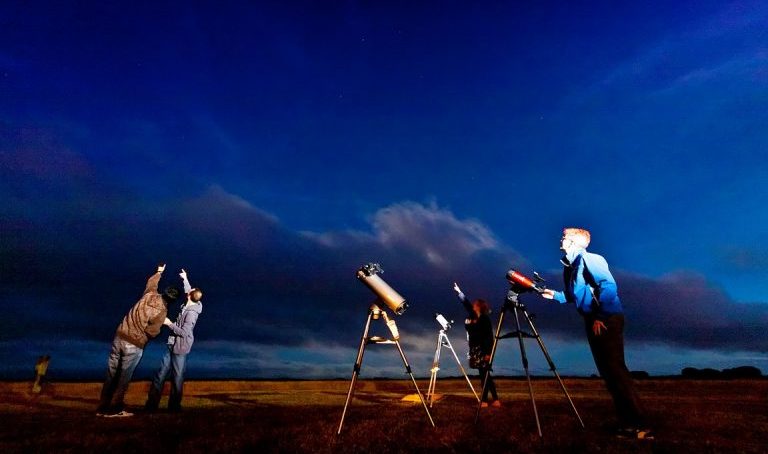
I spent every day of the previous ten years in a windowless office, working for a California-based Fortune 500 company that makes cleaning supplies. In March of 2016, I sat down in my director’s office and delivered the news. He sat across from me, tapping a pen on the desk, and glancing awkwardly out his giant window at the corporate parking lot. “I’m moving to Canada, to study astrophysics full time,” I said. At first he didn’t process the statement. In the midst of the 2016 presidential primaries, several folks in the office had been joking about moving to Canada. “You’re staying with the company, and I assume, staying in Finance,” he said. I wasn’t sure it was a question. “No,” I answered, “I’m leaving the company.”
Cleaning out my office, I found a novelty watch I’d received as a gift, the kind that shows the phases of the moon. Just a few months earlier, the director had presented me with a gold watch, a token of appreciation for ten years of service with the company. I stepped back into the director’s office, holding the astronomical watch. “This is for you,” I said. “Keep looking up.” He took the watch (still in its original box), smiled, and gave me a hug. This symbolized the beginning of the end of my career in Corporate America.
Later that week I was seated onboard a United Airlines 737 beside Dr. Daniel Angerhausen, a notable NASA astrophysicist. He wore large noise-canceling headphones, and it wasn’t until we landed that I spoke to him. I broke the ice by asking about the NASA patches and NASA stickers peppering his laptop, clothes, and bag. Angerhausen worked on SOFIA, the NASA 747 embedded with a 98-inch infrared telescope in the fuselage. He is a planet hunter, searching for extra-solar planets almost 1000 light years away. Though our chance meeting was purely coincidental, and we only spoke for a few minutes, the encounter reaffirmed I’d made the right decision. Here was someone who did exactly what I wanted to do, operating on the frontier of astronomy—and what I believe to be the frontier of the human condition: the search for life else ware in the universe.
In order to understand why I was willing to quit my job, I’d like to take you back to my journey into amateur astronomy.
My space interest solidified as a ten-year-old kid flipping through old issues of National Geographic. A nerd growing up, I was obsessed with Star Trek and chess club, but it wasn’t until my mid-twenties when I bought a $14-dollar telescope at Walgreens that astronomy became a passion. I bought the telescope after learning that NASA was finalizing it’s LCROSS mission, which involved crashing a spacecraft into the moon. I set up the telescope outside my apartment, pressed my crappy LG camera phone up to the eyepiece, and began filming at the precise time the crash was supposed to occur (you can watch the video here. Turns out the crash wasn’t visible from Earth, but a month or so later, I pointed the same telescope at Saturn, and that’s when everything changed…
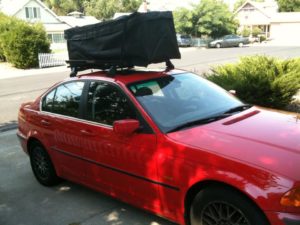
Transporting the optical tube of my 12-inch Dobsonian telescope.
Seeing the rings of Saturn for the first time is often compared to a religious experience. It’s just that dammed beautiful. A short time later, I purchased the Meade ETX 60 telescope on craigslist. The underwhelming 60mm diameter lens and shaky computerized mount showed me enough of the heavens to give me “Aperture Fever,” the desire to own bigger and bigger telescopes. The fever was soon cured with the procurement of a 12-inch Dobsonian Telescope, a scope so big, the optical tube had to be carried on the roof of the car.
With ample aperture and a hunger for all things space, I began working through the Messier objects (https://goo.gl/JACRu1), some of the brightest deep sky targets. I joined the local astronomy club and volunteered with the club’s outreach team, part of the NASA Night Sky Network.
After my first year of volunteering, and attending close to fifty star parties, I discovered that many students actually owned telescopes, but didn’t know where to point them. With this fact in mind, I put together my first publication, 50 Things to see with a Small Telescope. The book has been helpful to so many people, and often sits at number one in both the Astronomy and Stargazing sections of Amazon.
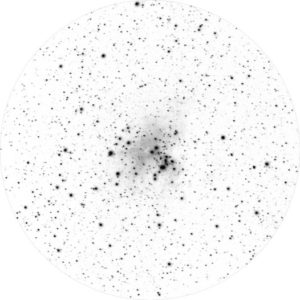
Eagle Nebula imaged to show a visual representation of the object.
For me, it’s not enough to see the wonders of the universe with my own eyes: I have this unquenchable desire to share my experience with the world, via twitter (@johnaaronread) or Facebook (http:// fb.me/50ThingstoSeewithaSmallTelescope). On this note, my approach is different than most. I own a computerized German equatorial mount, with a refractor capable of taking long exposures. However, I rarely photograph the night sky with perfection in mind. For me, the joy is in sharing the visual experience through photography, which means finding a way to simulate the visual experience. You can see the results in the adjacent image.
Photographing the International Space Station is probably my favorite experience to share. A DSLR camera connected to a telescope to produces images like the one shown below, right. A full description of my technique can be found here. My apologies for the video quality; it was filmed using an iPhone in my garage. Also, avoid the comment section, as it is often filled with hateful (yet amusing) comments from the Flat Earthers claiming the ISS is fake and that I must work for NASA (I don’t).
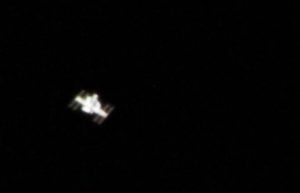
Photographing the International Space Station.
For several targets, iPhone imaging is more effective than traditional astrophotography. iPhone images of the moon can be done free hand (holding the phone up to the telescope eyepiece). These moon photos make great desktop backgrounds. The addition of an iPhone adapter can yield some fascinating results. Detailed deep sky imaging (galaxies and nebula) are typically off limits for the current generation of phone camera; their CCDs simply do not collect enough photons. However, there are apps that promise to bring deep sky into the realm of the phone. I’m skeptical, but open-minded. One example of such software is called NightCap, and can be found in the iTunes store.
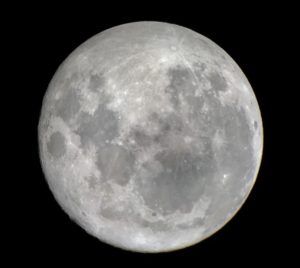
iPhone image of the moon through a Dobsonian telescope.
For planetary photography, the iPhone, combined with stacking software and a moon filter, yields impressive results. Most of the software required to process and stack the images is free. While it is possibly to take individual photos of the planets, (I’ve done it on several occasions), photos of detail must be stacked. Stacking involves multiple images of the same target layered on top of one another. This technique masks the noise generated by high ISOs and low light levels, while bringing out the subtle details from multiple frames. Photographer Andrew Symes uses these techniques with amazing results. Check out his Flickr page here.
I’m often asked, “What telescope I should buy?” I’ve created YouTube videos that address this question here. I get a certain amount of flack for not suggesting folks start with binoculars. Some (strongly) believe one should learn the night sky before graduating to a telescope. Maybe it’s because I’m a millennial, but in my experience (having now taught over 8,000 people how to use telescopes at several hundred events), people care more about “Seeing cool stuff,” than learning about the night sky. That’s just a reality, and one that requires a telescope to satisfy their desire. My book, 50 Things to See with a Small Telescope, and my social media posts assure that they won’t be disappointed. With that in mind, here are some “enthusiast” tips for taking the telescope experience to the next level.
- The most powerful telescopes per dollar are Dobsonians. The downside is that they’re large. If size doesn’t phase you, check this out. http://amzn.com/B003ZDDP06 . Keep in mind though, the best telescope is the one that you’ll actually use.
- You get more aperture per dollar with a reflector than a refractor, but if you’re looking for ultra portability, crystal clear views, and eventually a move to deep sky astrophotography, get a triplet refractor. These don’t come cheap, here is about the most basic option: http://amzn.com/B003KZ5ZQ6 (mount sold separately).
- Typically, I recommend Alt/Az mounts instead of Equatorial Mounts EQ. Alt/Az mounts are simpler, and as I said before, the best telescope is the one you’ll actually use. EQ mounts at low price points are often, well, terrible. If you are interested in an Equatorial Mount, here is the most basic model that isn’t crap (actually, it’s fantastic): http://amzn.com/B0175TQ4NA
- Unless your budget is in the thousands, don’t invest in a go-to telescope. The money is better spent on a telescope with a larger aperture. However, if you do want a go-to telescope, (and aren’t interested in deep sky astrophotography), here is one to consider: http://amzn.com/B00K6E1U1I This telescope is controlled via your smartphone, and has an internal power supply.
- If you want portability and aperture, consider a table stop Newtonian like this one: http://amzn.com/B00463ZK3O
Saint Mary’s University (my current Alma Mater), houses one of the world’s only Twitter-controlled observatories, @smubgobs, where anyone, anywhere, can take astro-images from their laptop or smartphone. This is a wonderful intersection where amateur meets professional, and science meets beauty. That’s where I’ve decided to play, everyday. And, with just eight years of astrophysics and planetary science education ahead of me, my adventure has just begun.
About the Author
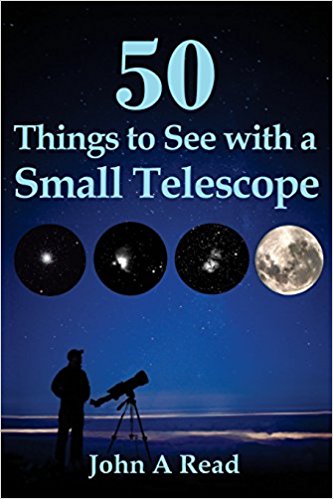 Shortly after receiving his pilot’s license as a Royal Canadian Air Cadet, John Read dropped out of Aerospace Engineering at Carleton University to pursue a degree (and career) in Corporate Finance. A few years later, his wife bought him a twelve-inch Dobsonian telescope for Christmas (to be fair, she got leather boots). He joined the Mount Diablo Astronomical Society, volunteering as many as four nights per week under California’s cloudless skies. During his time at MDAS he began writing essays for the club’s magazine, Diablo MoonWatch, and later published his first book, 50 Things to See with a Small Telescope, an Amazon best-seller, which has been followed by three additional titles. His Callisto Deception, the sequel to The Martian Conspiracy, will be released fall 2017. He studies Astrophysics at St. Mary’s University in Halifax, Nova Scotia.
Shortly after receiving his pilot’s license as a Royal Canadian Air Cadet, John Read dropped out of Aerospace Engineering at Carleton University to pursue a degree (and career) in Corporate Finance. A few years later, his wife bought him a twelve-inch Dobsonian telescope for Christmas (to be fair, she got leather boots). He joined the Mount Diablo Astronomical Society, volunteering as many as four nights per week under California’s cloudless skies. During his time at MDAS he began writing essays for the club’s magazine, Diablo MoonWatch, and later published his first book, 50 Things to See with a Small Telescope, an Amazon best-seller, which has been followed by three additional titles. His Callisto Deception, the sequel to The Martian Conspiracy, will be released fall 2017. He studies Astrophysics at St. Mary’s University in Halifax, Nova Scotia.




